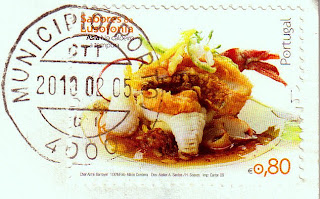Behold the Czech Republic’s EUROPA stamp a philatelic feast for the eyes, and my entry for this week’s Sunday Stamps with the theme food. Issued by the Czech Post in 2005, this illustrated stamp celebrates the nation’s culinary delights, where meat reigns supreme.

Poultry, pork, beef—you name it, Czech cuisine offers a variety of hearty options, often accompanied by their beloved knedliky. These dumplings are a carb-lover’s dream are a comforting staple, made from wheat or potato flour, lovingly boiled into a roll, then sliced and served piping hot. I stumbled upon a photo online that’s a virtual twin of the stamp’s illustration, minus the beer.

Now, let’s talk about the elephant in the room—or should we say, the beer in the mug? The stamp proudly features a frothy mug of beer, which is practically a national treasure in the Czech Republic.
Beer is not just a drink in the Czech Republic; it’s a way of life. The country boasts the highest beer consumption per capita on the planet. With legendary brands like Budweiser Budvar and Pilsner Urquell, the Czechs have made their mark on the global beer map. But wait, there’s more! The Czech Republic is home to over 470 different types of beer. That’s right, folks, 470. And with that 470 different types of beer, the Czech Republic offers more than one brew for every day of the year. Everyday is beer festival, hurrah!
I love this stamp. As a foodie and a stamp enthusiast – it’s a small rectangle of joy celebrating the big flavours of this vibrant culture. Collect, lick, and post… or better yet, I’m going find myself a Czech beer and pour myself a cold one and toast to the love of food and stamps! Na zdraví!
